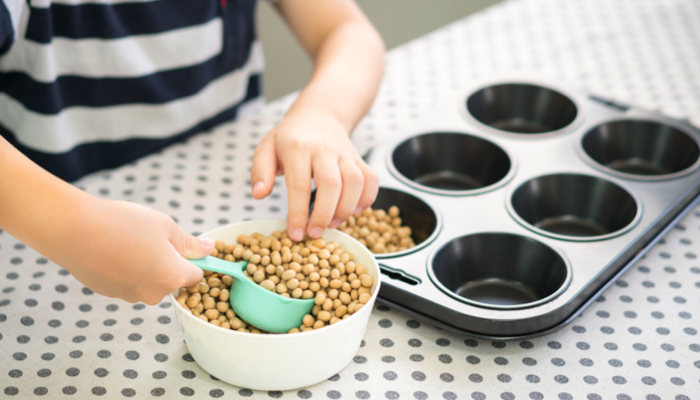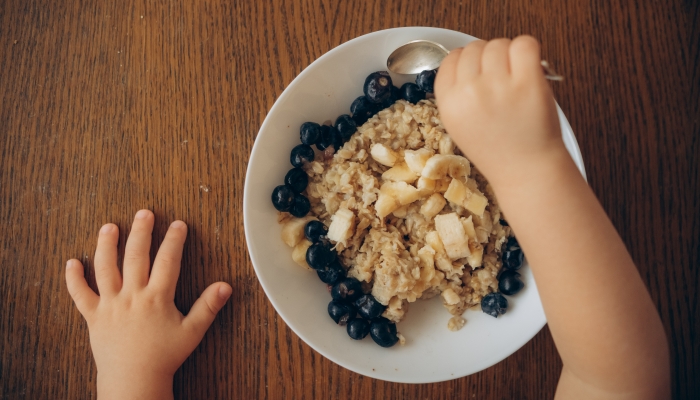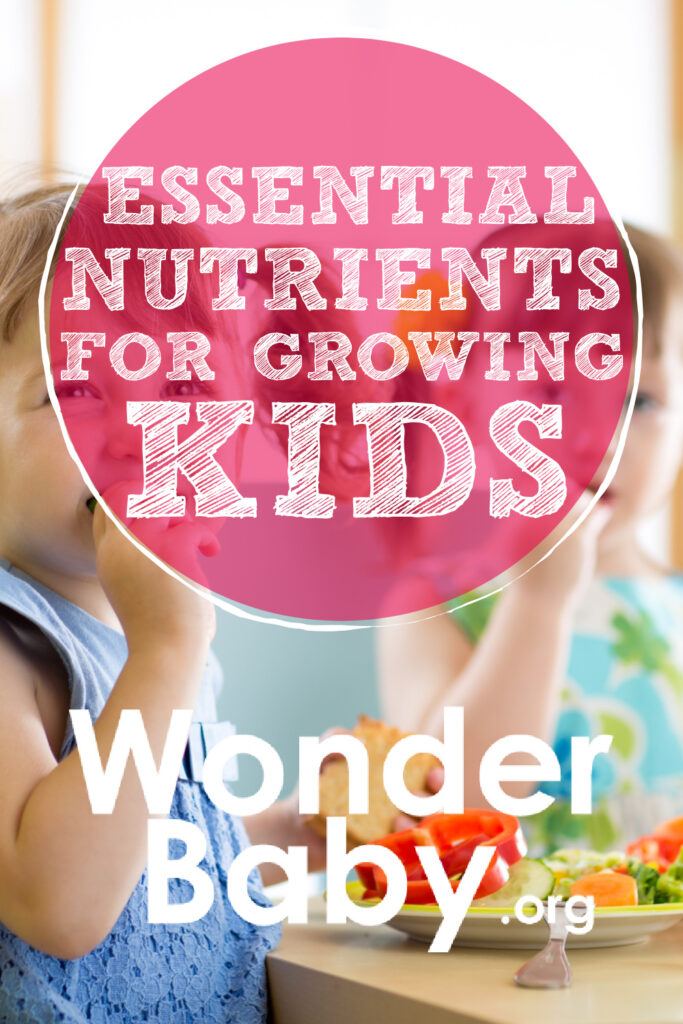Essential Nutrients for Growing Kids

- Animal or plant-based protein sources are an important part of your child’s daily diet.
- Adequate calcium intake in childhood positions your child for a lifetime of health benefits.
- Iron-rich foods provide your child’s growing body with the raw materials needed to create hemoglobin.
- Provide healthy sources of fiber through various foods to help keep your child full and promote bowel health.
Most parents understand that a healthy diet is important for growing kids for many reasons.
A well-balanced diet of macronutrients (proteins, fats, and carbohydrates) and micronutrients (vitamins and minerals) is key to helping children avoid illness, maintain a healthy weight, and achieve their growth potential.
However, if you’ve got a child with strong food preferences, food or texture aversions, or seems to exist solely on the occasional goldfish cracker, you may wonder how to balance your child’s nutritional needs with what they’ll tolerate eating.
Of the many vital nutrients we need, which are considered the most essential nutrients for growing kids?
We’ll explore the importance of four essential nutrients for kids and include food suggestions for each one. You may even tempt your child to put down the goldfish and try something new!
1. Protein

What do quinoa, lentils, sweet potatoes, and pumpkin seeds have in common?
In addition to chicken, red meats, and seafood, these foods are all excellent sources of protein.
Importance of Protein
Protein is a key nutrient for growing bodies.
Research studies11. UAUY, R., KURPAD, A., TANO-DEBRAH, K., OTOO, G. E., AARON, G. A., TORIDE, Y., & GHOSH, S.. Role of Protein and Amino Acids in Infant and Young Child Nutrition: Protein and Amino Acid Needs and Relationship with Child Growth. Journal of Nutritional Science and Vitaminology. 2015;61. https://doi.org/10.3177/jnsv.61.s192 have shown that children who consistently eat high-quality, protein-rich foods are more likely to achieve their height potential and experience healthy weight.
Further, amino acids (nine types of building blocks that make up protein’s molecular structure) aren’t made by the human body and are considered a necessary dietary nutrient22. U.S. National Library of Medicine. Protein and amino acids. Recommended Dietary Allowances: 10th Edition. 1989. https://www.ncbi.nlm.nih.gov/books/NBK234922/.
Protein also plays a key role in building muscle, repairing tissues, and producing enzymes and hormones necessary for your child’s healthy growth and development.
Best Sources

Does your child turn up their nose when asked to eat chicken or red meat?
Experts from Harvard Health33. Restivo, J.. High-protein foods: The best protein sources to include in a healthy diet. Harvard Health. 2023. https://www.health.harvard.edu/nutrition/high-protein-foods-the-best-protein-sources-to-include-in-a-healthy-diet and the American Heart Association44. Plant-Based Sources of Protein Infographic. www.heart.org. https://www.heart.org/en/healthy-living/healthy-eating/eat-smart/nutrition-basics/plant-based-protein-infographic suggest the following protein ideas to include in your child’s regular diet:
| Animal-based sources | Plant-based sources |
|
|
Note: If your child eats primarily plant-based protein sources, it’s a good idea to eat a variety of high-quality protein choices throughout the day.
Unlike animal-based protein sources, plant-based products may not include all nine essential amino acids in one food product.
Eating protein from a variety of sources ensures that your child is reaching their nutritional potential for this element each day.
2. Calcium

Did you know that the best time to prevent osteoporosis is in childhood?
Osteoporosis Prevention
The American Academy of Pediatrics (AAP)55. Calcium: The Bone Builder Kids & Teens Need. HealthyChildren.org. 2022. https://www.healthychildren.org/English/healthy-living/nutrition/Pages/calcium-the-bone-builder-kids-and-teens-need.aspx reports that a child’s body is at its highest need for calcium when your child is in their main growing years—approximately the ages of 9 to 18. When children reach young adulthood, they have achieved their peak bone density (the extent to which calcium can be stored in their bones) for life.
Over time, bones lose their capacity to store this essential nutrient. If the body doesn’t have enough calcium to meet its needs, it will take calcium from the bones to fulfill the requirement.
This, in turn, can increase the risk of osteoporosis as your child ages.
Added Benefits of Calcium
Calcium is also vital for muscle function, nerve signaling, and blood pressure regulation.
The National Institute of Health66. Calcium. NIH Office of Dietary Supplements. https://ods.od.nih.gov/factsheets/Calcium-Consumer/ reports the recommended daily amount for children below:
| Age | Recommended amount (in milligrams) |
| Birth to 6 months | 200mg |
| Infants 7 to 12 months | 260mg |
| Children 1 to 3 years | 700mg |
| Children 4 to 8 years | 1,000mg |
| Children 9 to 13 years | 1,300mg |
| Teens 14 to 18 years | 1,300mg |
| Pregnant and breastfeeding teens | 1,300mg |
Adequate vitamin D intake77. Vitamin D Supplements: What Parents Should Know. Children’s Hospital of Philadelphia. 2021. https://www.chop.edu/news/health-tip/vitamin-d-supplements-what-parents-should-know is also important to help the body process and absorb the calcium it receives.
Best Sources

While most people tend to think of dairy products as the primary source of calcium, there are other calcium-rich sources available that will ensure your growing child is still getting their daily required value.
This is good news if your child has a dairy allergy or cross-sensitivity to milk proteins.
The Bone Health and Osteoporosis Foundation (BHOF)88. A Guide to Calcium-Rich Foods. Bone Health & Osteoporosis Foundation. https://www.bonehealthandosteoporosis.org/patients/treatment/calciumvitamin-d/a-guide-to-calcium-rich-foods lists the following foods as excellent sources of this essential nutrient:
- Milk (including dairy, nut, and fortified plant milks)
- Cheese (like ricotta, parmesan, cheddar, and cottage cheese)
- Yogurt
- Oranges and calcium-enriched orange juice
- Leafy greens (such as broccoli, kale, collard greens)
- Soybeans and tofu
By consistently offering calcium-rich products at each meal, you’ll be well on your way to helping your child develop the strong bones and calcium stores they’ll need for the rest of their lives.
3. Iron

No, we’re not referring to lifting weights or smoothing out wrinkles in your clothes, but this essential nutrient does indeed “pump you up.”
Importance of Iron
Often considered the “workhorse” of the body, this essential nutrient supplies the raw materials necessary to create hemoglobin.
Hemoglobin is the transport molecule that carries oxygen (via the bloodstream) to the muscles, tissues, and major organs.
In a 2019 study99. Armitage, A. E., & Moretti, D.. The Importance of Iron Status for Young Children in Low- and Middle-Income Countries: A Narrative Review. Pharmaceuticals. 2019;12(2), 59. https://doi.org/10.3390/ph12020059, researchers reported that a growing child’s body requires consistent and sufficient iron ingestion to support body processes such as blood volume expansion, brain growth, tissue maintenance, and healthy immune function.
Without enough iron to make hemoglobin, children can develop anemia1010. Iron deficiency in children: Prevention tips for parents. Mayo Clinic. 2024. https://www.mayoclinic.org/healthy-lifestyle/childrens-health/in-depth/iron-deficiency/art-20045634, making it more difficult to play and enjoy a healthy lifestyle.
Best Sources

Suggestions for iron-rich foods from the Cleveland Clinic1111. 52 Foods High In Iron. Cleveland Clinic. 2023. https://health.clevelandclinic.org/how-to-add-more-iron-to-your-dietinclude:
- Red meat
- Poultry (like chicken and turkey)
- Eggs
- Fortified cereals and oatmeal
- Spinach
- Broccoli
- Beans (such as garbanzo, kidney, or cannellini)
- Dried fruits (raisins, apricots, figs, prunes)
Serve foods with this key nutrient with ones containing vitamin C to increase iron absorption.
4. Fiber

It’s not too early to begin thinking about your child’s fiber intake.
Importance of Fiber
Fiber can be considered a bonus on top of providing other necessary micronutrients to a child’s diet that facilitate optimal health, but it also has its own benefits.
Highly refined carbohydrates like white bread or white rice have the fiber and most nutrients removed. Fortification of other nutrients may be added back in later, but fiber typically is not.
Fiber also helps kids feel fuller, which may lead to decreased snacking throughout the day.
Many kids don’t get anywhere near their daily fiber recommendation, which is important for bowel health and regularity, and may play a role in preventing type 2 diabetes and obesity1212. Fiber & Healthy Kids. Boston Children’s Hospital. 2007. https://www.childrenshospital.org/sites/default/files/media_migration/c0e77168-ea9a-4d5f-8838-0523bc31bf4e.pdf.
Best Sources

Looking to provide fiber options that your child might actually eat?
Experts at Nationwide Children’s Hospital1313. High Fiber Diet. Nationwide Children’s Hospital. https://www.nationwidechildrens.org/family-resources-education/health-wellness-and-safety-resources/helping-hands/high-fiber-diet suggest foods like:
- Whole grains (such as brown rice or quinoa)
- Whole fruits and vegetables
- Carrots
- Strawberries, blueberries, or blackberries
- Peas
- Nuts
- Oats
- Popcorn
- Whole grain crackers
Serving washed fruit and vegetables with their skins on (like peaches, apples, and carrots) is also an easy way to promote fiber intake.
Providing your children with the essential nutrients they need to nourish their growing bodies doesn’t have to be boring. By enjoying a variety of healthy foods together and encouraging your child to make wise food choices, kids of all ages can reap the nutritional benefits that will help them enjoy an active, healthy lifestyle.
References
- UAUY, R., KURPAD, A., TANO-DEBRAH, K., OTOO, G. E., AARON, G. A., TORIDE, Y., & GHOSH, S. (2015). Role of Protein and Amino Acids in Infant and Young Child Nutrition: Protein and Amino Acid Needs and Relationship with Child Growth. Journal of Nutritional Science and Vitaminology, 61(Supplement). https://doi.org/10.3177/jnsv.61.s192
- U.S. National Library of Medicine. (1989, January 1). Protein and amino acids. Recommended Dietary Allowances: 10th Edition. https://www.ncbi.nlm.nih.gov/books/NBK234922
- Restivo, J. (2023, December 1). High-protein foods: The best protein sources to include in a healthy diet. Harvard Health. https://www.health.harvard.edu/nutrition/high-protein-foods-the-best-protein-sources-to-include-in-a-healthy-diet
- Plant-Based Sources of Protein Infographic. www.heart.org. (n.d.). https://www.heart.org/en/healthy-living/healthy-eating/eat-smart/nutrition-basics/plant-based-protein-infographic
- Calcium: The Bone Builder Kids & Teens Need. HealthyChildren.org. (2022, September 27). https://www.healthychildren.org/English/healthy-living/nutrition/Pages/calcium-the-bone-builder-kids-and-teens-need.aspx
- Calcium. NIH Office of Dietary Supplements. (n.d.). https://ods.od.nih.gov/factsheets/Calcium-Consumer
- Vitamin D Supplements: What Parents Should Know. Children’s Hospital of Philadelphia. (2021, May 4). https://www.chop.edu/news/health-tip/vitamin-d-supplements-what-parents-should-know
- A Guide to Calcium-Rich Foods. Bone Health & Osteoporosis Foundation. (n.d.). https://www.bonehealthandosteoporosis.org/patients/treatment/calciumvitamin-d/a-guide-to-calcium-rich-foods
- Armitage, A. E., & Moretti, D. (2019). The Importance of Iron Status for Young Children in Low- and Middle-Income Countries: A Narrative Review. Pharmaceuticals, 12(2), 59. https://doi.org/10.3390/ph12020059
- Iron deficiency in children: Prevention tips for parents. Mayo Clinic. (2024, February 7). https://www.mayoclinic.org/healthy-lifestyle/childrens-health/in-depth/iron-deficiency/art-20045634
- 52 Foods High In Iron. Cleveland Clinic. (2023, March 15). https://health.clevelandclinic.org/how-to-add-more-iron-to-your-diet
- Fiber & Healthy Kids. Boston Children’s Hospital. (2007). https://www.childrenshospital.org/sites/default/files/media_migration/c0e77168-ea9a-4d5f-8838-0523bc31bf4e.pdf
- High Fiber Diet. Nationwide Children’s Hospital. (n.d.). https://www.nationwidechildrens.org/family-resources-education/health-wellness-and-safety-resources/helping-hands/high-fiber-diet

The information WonderBaby provides is not intended to be, and does not constitute, medical or other health advice or diagnosis and should not be used as such. Always consult with a qualified medical professional about your specific circumstances.
Related Posts

Eye Conditions and Syndromes, Visual Impairment
Neuralink Announces Plans to Restore Sight to the Blind with Brain Chip
Elon Musk’s company Neuralink has announced plans to begin human trials of its new “Blindsight” brain chip by the end of 2025.

Health & Nutrition
Can Baby Skin Care Products Expire?
Is that forgotten tube of diaper rash cream still safe to use? Learn more about the expiration dates of popular skin care products for infants.

Health & Nutrition
Boosting Immunity in Kids: 3 Tips for a Healthy Winter
Parents can help boost their kids’ immunity during cold and flu season by maintaining healthy eating, sleeping, and exercising habits in the winter.